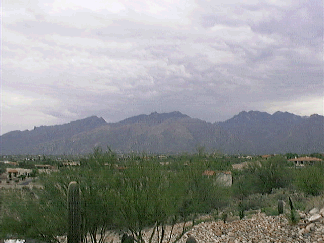|
Entertainment Magazine: Tucson: Santa Catalina Mission First written accounts of the Santa Catarina visitaThis is an excerpt from the book "Treasures of the Santa Catalina Mountains" by Robert E. Zucker. Download a free PDF sample of the book and purchase on Amazon.com.
In a 1689, May 11, letter from Juan de Escalante to Gen. Blas de Castillo letter concerning state of the Sonoran frontier. Says mines are being abandoned because of Indian ambushes in Sonora. (UAiR #041-00751). Escalante was part of the Compania Volante the “Flying Company” that roamed the Alt Pimeria frontier area and provided escorts for the missionaries. “That the Northern Piman Indians had had some experience with slave raiding and forced labor in the mines is indicated in their behavior toward Father Eusebio Francisco Kino, the founder of the first northern Piman mission. When he tried to interest some Indians north of his mission in forming a visitation station, they refused. They as much as accused the Jesuit of being an advance-man for the mine operators seeking new labor. They had heard, they told him, that he carried a cedula from the king exempting the northern Piman converts from repartimiento. They did not believe him, they said, because if he had one he would have shown it to the civil officer in charge of the mine camp nearest them, Bacanuche (Bolton 1948:I:114) (“Tubac Four Centuries: An Historical Resume and Analysis, iv, A”). Bacanuche was about 20 leagues northwest of Dolores. Location #1: West of Santa Cruz, NW Picacho Peak1697, According to Padre Kino’s journal, "La Mision de Santa Catalina, sobre el Santa Cruz" was in the rancheria of Santa Catarina de Cuituabaga and its fields at Akohin. It was located some 15 miles northwest of San Augustin de Oiaur (“Tucson”). 1697, Nov 10, Kino and Manje (Luz de Tierra Incógnita, libro ii, 60) states that they started home by way of Santa Catarina de Cuituabagu, La Valle de Correa, San Agustín de Oiaur, San Xavier del Bac, Tumagácori, Guevavi, Bacuancos, San Lázaro, Cocóspera, Los Remedios, and thence to Dolores. (Kino Memoirs, 170) Kino had named it Santa Catarina on November 23, 1697. The following year, Captain Diego Carrasco received their oath of obedience on September 28. 1697, Introductory letter and report on expedition made by teniente Capt Cristobal Martin Bernal and a company of twenty soldiers from Corodeguachi, Sonora into the Pimeria as far as the Gila. Names included Escalante, Juan (Sargento), Kino, Eusebio Francisco (Padre). Named among locations: Santa Catalina (Rancheria) (AUiR 040-00319) 1699, Nov 17 Kino, Sr. Lt. and Antonio Cortez pass through Santa Catarina del Cuytoabagum (Caytuabaga, Manje) and found 300 men who represent 300 families, and more than 1,000 people, a journey of 15 leagues (51.78 miles) from San Agustin del Oyaut. (Kino Memoirs, 206). Pima word for “well where people gather mesquite beans.” (Kino, v2, 310) Also called Coytoabagum (Ezell, Hispanic Acculturation, 334) 1700, January 29: Letter “Juan Baptista de Escalante (Alferez). Operations in the war which is being waged against the rebellious Indians.” (UAiR #100-01242). He was Alfarez of Sonora until he retired in 1722 to become teniente alcalde mayor of the mining town of Motepori, where he held that position in 1689. (UAiR 19764). Escalante was a Sergeant on the Compania Volarte Sonora. He founded the towns of Magdelena de Kino, Los Angeles, Hermosillo. In 1723, he managed a section of Nacozari. 1700, April 25 Kino spent seven days in conference with Indians from the Papago desert country, from the San Pedro valley, from Santa Catalina, and from as far north as San Andres on the Gila River. That night, justices from Santa Catalina, Rio and Casa Grande met with Kino at San Xavier to discuss the origin of the “blue shells.” Escalante accompanies Kino’s party. (Kino Memoirs, 235-237) April 28, 1700 Kino lays the foundation of a large church and house at San Xavier de Bac. On the 30th, he went to San Cosmé and San Agustin rancherias to baptize children. 1702, April 2: Kino got “certain news of the treasure and rich mines which have just been discovered near here at Quisuani, Aygame, San Cosmé, etc., and very near to the new conversion or mission of San Francisco Xavier of the Pimas Cocomacaques of Pimeria Baxa… In this way even with every great good fortune and profit to ourselves, by divine grace, we will bring it about that, so many souls being converted, fiat unus pastor, et unum ovile…” (Memoirs of Kino, 362) 1704, January 20: Letter from Capitan Juan Matheo Mange. Hablando de la compania Volante, testimony labeled parafos y puntos sacados de los parezeres de Sonora, concerning the use of Companias Volantes for purposes other than strictly military. Includes name of Escalante, Juan Baptista de (Alferez); Manje, Juan Mateo (Capt) (UAiR, 01-20-1704) 1707, Santa Catalina, placed on the west side of the Santa Cruz, on Kino’s map (Navigation Methods of Kino, Ives). Map of Pimeria Alta, 1687-1711 from Bolton places it on the riverbank. 1711 Father Kino dies. 1720-1752, Francisco Xavier de Escalante serves in the Frontera garrison in the northern Piman frontier. Lieutenant in 1752. Played a role in deciding location of new forts in northern Pimerian after the Pima Indian Revolt. (Escalante, Apr. 22, 1752:90v-) (“Tubac Through Four Centuries,” Henry Dobyns) 1724, Padre Campos held services at S. Catalina de Actun; (Keller in 1736, 1737, and 1743) Source: US Dept Interior, Father Kino, Frank Pinkley. Treasures of the Santa Catalina MountainsTucson Entertainment Magazine© 2012-2018 EMOL.org / Tucson Entertainment Magazine On Line. All rights reserved. |
